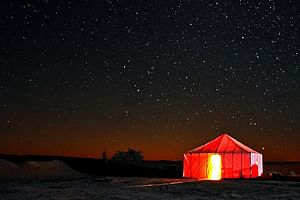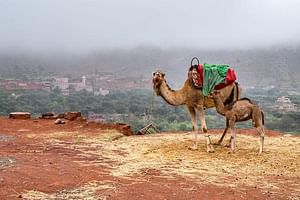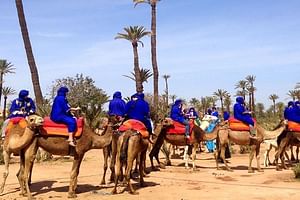Part of our revenue from this experience
will go to a charity in the region
will go to a charity in the region
A perfect combination of culture, adventure, and relaxation, this 8-day itinerary covers the imperial city of Marrakech and crosses the High Atlas Mountains into the desert. Explore desert towns, camp in the Sahara, and relax in the coastal town of Essaouira.
Duration
8 days
The tour starts at
Marrakesh, Morocco
-
Day 1
Explore MarrakechExplore Marrakech -
Day 1
Nicknamed the "Red City" (for its 1000-year old red sandstone city walls and buildings), Marrakech is a major economic center and home to a thriving medina (old Arab quarter). Orient yourself around A...Nicknamed the "Red City" (for its 1000-year old red sandstone city walls and buildings), Marrakech is a major economic center and home to a thriving medina (old Arab quarter). Orient yourself around Africa's busiest square, Jemaa el-Fna, and begin your day exploring the 12th-century Koutoubia Mosque and take a respite from the heat in its gardens amid fountains and palms. From there, find the Islamic school, Ben Youssef Madrasa, for a taste of 16th-century architecture and marvel at the exquisite details: arabesques, Islamic calligraphy, and colorful zellij (intricate tilework). As you walk Marrakech's alleys, notice the Fondouks—medieval traveler inns along ancient trade routes that provided merchants with shelter and supplies. Some have been converted into residential properties today, while others are large shopping areas and workshops that you can explore. You may wish to visit a few sites south of Jemaa el-Fna. Some options to consider are the 500-year old Saadian Tombs. -
Day 2
Over the High Atlas Mountains to Ouarzazate & Boumalne DadesOver the High Atlas Mountains to Ouarzazate & Boumalne Dades -
Day 2
Leave the busy city behind and head east toward the desert, ascending the High Atlas mountains. See if you can spot Mount Toubkal, the highest peak at 13,671 feet (4,167 m). Along the way, you will pa...Leave the busy city behind and head east toward the desert, ascending the High Atlas mountains. See if you can spot Mount Toubkal, the highest peak at 13,671 feet (4,167 m). Along the way, you will pass many Berber villages—made up of traditional mud-brick buildings. Lunch in Taddert and tour the local Argan Oil Cooperative and discover how the local women extract the precious oil from the argan nut to make oil used in the health, food, and cosmetic industries. Follow the winding road to the Tizi n'Tichka pass and stop to appreciate the panoramic view. Continue east to the desert hub and filming location of Ouarzazate. Join a movie studio tour and discover which of your favorite movies were filmed in the nearby desert regions. Movie buffs may appreciate a visit to the Musée du Cinema. Travel along the Valley of a Thousand Kasbahs towards Boumalne Dades, passing many small towns where you will see traditional farming methods in use. -
Day 2
HotelHotel -
Day 3
Desert Towns & Camping in the SaharaDesert Towns & Camping in the Sahara -
Day 3
Today you will drive further east to your final destination: the sand sea of Erg Chebbi outside of Merzouga. Along the way, stop in Tinerhir to admire the river oasis that extends on either side of th...Today you will drive further east to your final destination: the sand sea of Erg Chebbi outside of Merzouga. Along the way, stop in Tinerhir to admire the river oasis that extends on either side of the town. The surrounding desert landscape reveals impressive buttes, mesas, and plateaus. Nearby, you will have the opportunity to explore the Todra Gorge, a 984 feet (300 m) deep ravine cut by the Todra River. Continue to the desert town of Erfoud. Known for its figs and fossils, visit a craft workshop and discover how the fossil-rich rocks are skilfully transformed into practical and decorative objects. As you near Merzouga—the town closest to the Sahara—stop in the market town of Rissani and be sure to visit the livestock auction as well as the "donkey parking lot." Leaving Rissani behind, you will start to see the beginnings of the massive sand sea of Erg Chebbi looming on the horizon. -
Day 3
CampCamp -
Day 4
Date Palms, Alnif, & Aït Benhaddou KasbahDate Palms, Alnif, & Aït Benhaddou Kasbah -
Day 4
Rise early to witness a Saharan sunrise before exploring more of the Desert: rent a sandboard, join the Erg Shibi tour (around the sand dunes), or a quad ATV tour. Head south to Khemliya to explore th...Rise early to witness a Saharan sunrise before exploring more of the Desert: rent a sandboard, join the Erg Shibi tour (around the sand dunes), or a quad ATV tour. Head south to Khemliya to explore this traditional Saharan village. You will have a second chance to stop in Rissani to visit Maison Tuareg, a storehouse selling traditional carpets, jewelry, and leather goods. From there, pass through umbrella-shaped trees of the acacia forests before reaching Alnif for lunch. Continue through the Draa Valley, dense with date palmeries and the opportunity to pick up a box of dates for the drive. Travel west to medieval Aït Benhaddou. A protected UNESCO site, Aït Benhaddou, is the most famous kasbah (fort or fortification) in Morocco. Once upon a time, it held an important position along the trans-Saharan trade route between Marrakech, Ouarzazate. -
Day 4
Travel west to medieval Aït Benhaddou. A protected UNESCO site, Aït Benhaddou, is the most famous kasbah (fort or fortification) in Morocco. Once upon a time, it held an important position along the...Travel west to medieval Aït Benhaddou. A protected UNESCO site, Aït Benhaddou, is the most famous kasbah (fort or fortification) in Morocco. Once upon a time, it held an important position along the trans-Saharan trade route between Marrakech, Ouarzazate, and the southern desert. Spend the night in the old town and wander the empty alleys after the day-crowds have left. Pay a nominal fee to enter a few kasbahs and climb up to the rooftop for pretty views. You will have the option of staying here for the night or stopping in Ouarzazate 45 minutes earlier. -
Day 4
HotelHotel -
Day 5
Return to MarrakechReturn to Marrakech -
Day 5
Before the crowds filter into the old kasbah, explore the narrow passageways and alleys to get a real feel for this 11th-century fortified city. Leave Aït Benhaddou behind, and return to Marrakech, t...Before the crowds filter into the old kasbah, explore the narrow passageways and alleys to get a real feel for this 11th-century fortified city. Leave Aït Benhaddou behind, and return to Marrakech, traveling one more time up and over the High Atlas mountains and through the Tizi n'Tichka Pass. As you descend the north-facing slopes of the High Atlas, you will notice a dramatic change in climate and landscape. After all the tranquillity of the mountains and the desert, soon you will be in the midst of the hustle and bustle of Marrakech. You may want to spend the rest of the afternoon at a slower pace. Jemaa el-Fna comes alive with musicians, performers, snake charmers, and games in the early evening. As the Square is best experienced in the evening, roam its stalls and vendors taking in the spectacle. Grab a bite at one of the many food stalls or if you want to enjoy the goings-on from a distance, choose one of the cafés surrounding Jemaa el-Fna and enjoy a cup of mint tea and a meal. -
Day 5
HotelHotel -
Day 6
Essaouira: Seaside Ramparts, Kitesurfing, & Fresh SeafoodEssaouira: Seaside Ramparts, Kitesurfing, & Fresh Seafood -
Day 6
After breakfast, make your way west to the Atlantic coast and the laid-back beach town of Essaouira. The route along the way takes you over extensive, rolling plains and through endemic argan forests....After breakfast, make your way west to the Atlantic coast and the laid-back beach town of Essaouira. The route along the way takes you over extensive, rolling plains and through endemic argan forests. If you're lucky, you may see goats in the trees grazing on the argan fruit, a sight seen when grass pasture is limited or unavailable. Arrive in the port city of charming Essaouira, a nice contrast to frenetic Marrakech, and spend the rest of the day as you choose. Peruse the UNESCO-protected medina, spend some time on the coast riding horses or taking a kitesurfing lesson, or walk the Skala de la Kasbah (the 18th-century seafront ramparts) along the coast. Designed by European engineers, old brass cannons line the walls and offer viewing access over the Atlantic. Jimi Hendrix fans may want to take a short taxi ride to Diabat at the end of Essaouira's beach, where he reportedly spent some time. Walk back to Essaouira and enjoy a meal of freshly caught seafood. -
Day 6
HotelHotel -
Day 7
Return to MarrakechReturn to Marrakech -
Day 7
Known as the "Windy City" for its strong Alizée trade winds that hit its crescent beach, Essaouira is a popular kitesurfing destination. Take the morning to watch the kiteboarders or, for the more ad...Known as the "Windy City" for its strong Alizée trade winds that hit its crescent beach, Essaouira is a popular kitesurfing destination. Take the morning to watch the kiteboarders or, for the more adventurous, enjoy a lesson before saying goodbye and returning to Marrakech. Along the way, there is an option to stop at an Argan Oil Cooperative to see how the precious and expensive oil is extracted from the nut. -
Day 7
Spend some time exploring Dar Di Said Museum (also known as the Museum of Moroccan Arts) to see exhibits of clothing, antiques, jewelry, and beautifully carved Hispano-Moorish decorations of carved ce...Spend some time exploring Dar Di Said Museum (also known as the Museum of Moroccan Arts) to see exhibits of clothing, antiques, jewelry, and beautifully carved Hispano-Moorish decorations of carved cedarwood. Afterward, indulge your senses as you explore the complicated labyrinth of souks (markets) tucked behind ordinary restaurants and shops. Check out Souk el Attarin, Souk Chouari, and Souk Smata to select spices, woodwork, and babouche (traditional Moroccan slippers). Visit Souk des Teinturiers (the dyers’ souk) to see how cloth and yarn are dyed using traditional methods. -
Day 7
HotelHotel -
Day 8
Depart MarrakechDepart Marrakech -
Day 8
Depending on your flight details, discover the only surviving Almoravid monument, the 12th-century Almoravid Koubba, before spending some time in the Marrakech Museum. Housed in the 19th-century Dar M...Depending on your flight details, discover the only surviving Almoravid monument, the 12th-century Almoravid Koubba, before spending some time in the Marrakech Museum. Housed in the 19th-century Dar Mnebbi Palace, the museum is home to a large exhibit of both modern and traditional art. It includes artifacts of Berber and Moroccan Jewish and Islamic cultures.
Breakfast
Dinner
Dinner
Featured Experiences

$58 / person
Quad Bike Marrakech
Duration: 3 hours

$549 / person
Randonnée dans désert Marocain 3jours
Duration: 3 days
© 2020 XplorPal. All Rights Reserved










